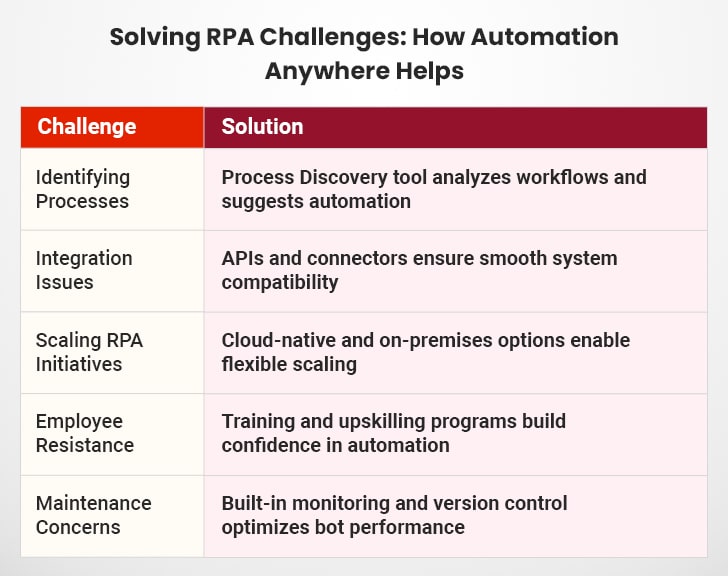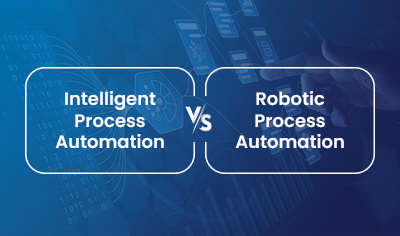Robotic Process Automation (RPA) has emerged as a game-changer for organizations seeking innovative ways to reduce costs, increase productivity, improve efficiency, enhance customer satisfaction, and gain a competitive edge.
The path to successful RPA implementation is fraught with a myriad of challenges. From navigating complex IT infrastructures to ensuring seamless integration with legacy systems and existing workflows, many organizations find themselves grappling with a myriad of obstacles that can hinder the successful deployment of RPA. This is where Automation Anywhere, a leader in the RPA industry, steps in with its cloud-native intelligent automation platform designed to overcome the common RPA challenges. It also paves the way for organizations to realize the full potential of automation. Let’s explore Automation Anywhere features and benefits before delving into how it helps businesses overcome common RPA challenges.
Table of Contents
Key Features of Automation Anywhere
Benefits of Automation Anywhere
- I. Cost Savings
- II. Enhanced Accuracy
- III. Scalability for Expanding Businesses
- IV. Better Compliance and Security
- V. Seamless Integration
Overcoming Common RPA Challenges with Automation Anywhere
Key Features of Automation Anywhere
1. Bot Creator
Automation Anywhere in RPA simplifies the creation of software robots with Bot Creator. The drag-and-drop feature enables users to automate processes, such as data entry and form filling. Bots operate 24/7, minimizing manual labor and maximizing efficiency. The product accommodates proprietary scripts and interoperates well with current systems. Companies can utilize bots in numerous workflows, resulting in time saving. Being a part of the Automation Anywhere platform, Bot Creator assists businesses in automating their processes and scaling automation with ease.
2. Bot Runner
Bot Runner is programmed to run bots fast and precisely. It achieves error-free automation by executing the set instructions. Companies run multiple bots at the same time, increasing productivity. Bot Runner supports cloud and on-premises, giving flexibility. The system is monitored in real time for bot activity, enhancing performance monitoring.
3. IQ Bot (AI-Powered Automation)
IQ Bot applies AI-powered automation to handling unstructured data. It reads and interprets emails, invoices, and forms, minimizing the need for manual intervention. It uses machine learning to improve accuracy. The tool benefits sectors like healthcare, finance, and retail, where high volumes of data require processing. Incorporating IQ Bot into their Automation Anywhere workflow helps companies improve efficiency and minimize errors.
4. Control Room (Centralized Management)
Control Room is the organization’s central management hub for automation. It enables users to schedule, monitor, and control bots from one place. Companies using Automation Anywhere enjoy role-based access control for data security and compliance. Real-time insights help businesses monitor bot performance and optimize processes. The Automation Anywhere platform facilitates secure automation scaling in the cloud and on-premises.
5. AARI (Attended Automation)
AARI (Automation Anywhere Robotic Interface) is an on-staff digital assistant that enhances attended automation. It assists the workforce in getting jobs done quicker by automating repetitive tasks within CRM and ERP applications. Employees can deploy bots when needed, enabling an efficient human-bot partnership. AARI enhances customer service automation by ensuring faster response time and accuracy. AARI automates business tasks seamlessly with its business applications to make automation simple for teams.
6. Analytics and Insights
Automation Anywhere in RPA offers sophisticated analytics to gauge automation performance. Companies using Automation Anywhere can monitor key metrics and receive real-time insights into bot performance. Custom reports assist in visualizing automation success and indicate areas for enhancement. These Automation Anywhere capabilities also help track compliance, ensuring companies comply with regulatory requirements. Through data-driven insights, companies maximize their automation anywhere workflow and improve decision-making.
7. Cloud Automation
Cloud automation is one of the most beneficial capabilities of Automation Anywhere. It allows companies to control bots remotely. Automation Anywhere provides a secure, scalable solution that saves IT costs. Bots are executed in real-time without infrastructure constraints, resulting in quicker deployment. Businesses enjoy seamless integration of Automation Anywhere with other third-party applications, ensuring workflows are executed smoothly across applications. With inherent security features, cloud automation offers a secure method to scale automation activities efficiently.
8. Process Discovery
Process Discovery allows companies to find the right tasks to automate. With the help of AI, it charts processes and identifies where automation can create value. Companies receive real-time visibility into operations, reducing the time needed to conduct manual analysis. Process Discovery assists companies in optimizing resources and concentrating on high-impact automation. By adding Process Discovery to their Automation Anywhere process, companies simplify processes and increase efficiency.
Benefits of Automation Anywhere
I. Cost Savings
Cost reduction is one of the biggest advantages of Automation Anywhere in RPA. Automating repetitive tasks minimizes the level of manual intervention, hence lowering operational expenses.
Through Automation Anywhere integration, companies avoid mistakes that may result in money loss. These savings enable companies to invest their budget in growth and innovation rather than manual work. Automation ultimately results in higher returns on investment.
II. Enhanced Accuracy
Hand-processing information frequently produces inaccuracies, resulting in inefficiency and rework. The features and overall benefits of Automation Anywhere bring in higher accuracy by removing human error in repetitive tasks.
The system also tracks all actions, providing transparency and traceability. By incorporating bots in the Automation Anywhere workflow, companies minimize expensive mistakes and improve the quality of their operations overall.
III. Scalability for Expanding Businesses
As companies expand, their business needs grow. Automation Anywhere in RPA facilitates scalable automation, enabling companies to scale without added expense.
From automating a single task to an entire department’s workflow, the platform scales according to business needs. Businesses employing Automation Anywhere can scale automation activities across teams and locations.
Through Automation Anywhere integration, businesses implement seamless transitions without interrupting ongoing processes. The scalability of automation renders it effective for small enterprises and large organizations, enabling businesses to grow in an efficient manner with high performance.
IV. Better Compliance and Security
Most sectors need rigorous adherence to compliance rules. Automation Anywhere functionality includes integrated security features to secure confidential information. Automation Anywhere for RPA sees to it that automated tasks abide by industry norms, reducing the chances of violation.
Automation Anywhere applications provide role-based access as well as audit logs to secure data against unauthorized amendments. Firms utilizing Automation Anywhere gain access to automated regulation checks, thereby reducing manual handling of regulation steps. Secure automation reduces the possibilities of data loss or errors and, hence, of legal transgression.
V. Seamless Integration
One of the greatest advantages of Automation Anywhere integration is its capability to operate with current business applications. The platform easily integrates with CRM, ERP, cloud providers, and databases to provide effortless automation without disrupting operations.
It enables companies to automate processes without having to replace existing software. The Automation Anywhere capabilities facilitate seamless interaction of bots with legacy systems, hence simplifying business migration into automation.
Overcoming Common RPA Challenges with Automation Anywhere

Now, let’s explore common RPA challenges and how to overcome them with Automation Anywhere.
1. Identifying the Processes Suitable for Automation
Identifying the high-impact processes for automation is a crucial step in the RPA journey, yet it’s a significant challenge. Many organizations often struggle to determine which processes are suitable for automation and which ones require human intervention. Processes that are high-volume, rule-based, and recurring are typically considered the best candidates for automation.
However, recognizing them within complex business operations can be nerve-wracking. Poor selection can lead to underwhelming results, including wasted resources and minimal ROI.
Automation Anywhere addresses this common challenge with its advanced analytics and process discovery tools. The platform’s proprietary Process Discovery tool leverages advanced algorithms to analyze process workflows and identify areas where automation can deliver the maximum return on investment.
This data-driven approach empowers organizations to make informed decisions about which processes to automate. Besides this, Automation Anywhere consultants work closely with clients to understand their automation requirements and devise a strategic roadmap that seamlessly aligns with their unique business objectives.
By using the Process Discovery tool and the expertise of Automation Anywhere consultants, organizations can overcome the challenge of identifying suitable processes for automation while ensuring their RPA initiatives are aligned and effective.
2. Integration with Existing Systems
Another significant challenge that many organizations face in their automation journey is integrating digital workers with existing systems. This can be a complex and time-intensive process, particularly, when dealing with rudimentary APIs or legacy systems since they pose significant roadblocks that can hinder seamless automation.
Automation Anywhere tackles this challenge by supporting various integration methods, including connectors, APIs, and web services that facilitate seamless data exchange and process automation. This capability minimizes the need for extensive reconfiguration since digital bots can interact effortlessly with a wide range of existing systems and applications. Furthermore, Automation Anywhere provides end-to-end support for both modern and legacy systems, enabling organizations to bridge the gap between different technologies while ensuring a smooth and efficient automation process. In a nutshell, Automation Anywhere streamlines the integration process with existing systems and applications by leveraging connectors, APIs, and web services.
Automate Complex Business Processes with RPA
3. Scalability of RPA Initiatives
Scalability poses a significant challenge when organizations strive to expand automation initiatives from pilot projects to enterprise-wide deployment. This challenge arises particularly due to resource constraints, technical limitations, and the complexity of managing a growing number of automated processes.
Automation Anywhere addresses this challenge with its scalable architecture that quickly adapts to changing business needs. For instance, the platform allows organizations to start small pilot projects and scale their automation initiatives as needed, without making significant infrastructure changes.
The best part of Automation Anywhere is that it supports both on-premises and cloud-native automation deployments. It provides businesses the flexibility to scale RPA initiatives as per the changing requirements. In a nutshell, the scalable architecture of Automation Anywhere allows organizations to quickly scale their automation initiatives from initial proofs of concept to enterprise-wide deployments.
4. Employee Resistance to Change
Employee resistance to change is one of the common obstacles in implementing Robotic Process Automation (RPA). This resistance primarily stems from various factors, including concerns about job security, lack of understanding of automation benefits, the need to adapt to new technology, and more. Overcoming this challenge is critical to realize the benefits of automation.
Automation Anywhere tackles this challenge by providing resources to help decision-makers articulate how automation frees employees from mundane and repetitive tasks and allows them to focus on more strategic, higher-value activities. This not only reduces the fear but also fosters a positive perception of automation among the employees.
Besides this, Automation Anywhere provides comprehensive training and upskilling to facilitate change management. These programs not only equip the workforce with the skills and knowledge needed to work alongside automation but also ensure that employees feel confident in their new roles.
Kickstart Your Automation Expedition with RPA Use Cases
5. Insufficient Maintenance
Insufficient maintenance can turn the automation dream into a nightmare. Intelligent bots are like any other software that demands regular upkeep. Without regular maintenance, bots can become inefficient, outdated, and prone to errors leading to errors, bugs, and operational disruptions.
Automation Anywhere tackles this challenge by providing built-in bot monitoring and logging tools that not only allow organizations to identify and fix errors before they escalate but also monitor bot performance in real-time. Besides this, Automation Anywhere supports version control systems and automated updates, ensuring bots are running on the latest versions.
Summing Up
The path to successful RPA implementation is laden with challenges from identifying suitable processes for automation to integration complexities, scalability issues, and Insufficient maintenance. However, with the right strategies and tools, organizations can navigate these obstacles confidently. Automation Anywhere, a leader in intelligent automation empowers businesses to realize the full potential of RPA by providing comprehensive support. If you are also planning to embark upon the automation journey, leveraging Automation Anywhere capabilities can play an instrumental role in achieving transformative business outcomes.






